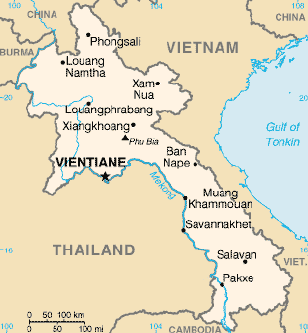LAOS GEOGRAPHY
|
Most of the western border of Laos is demarcated by the Mekong River, which is an important artery for transportation. The Khong falls at the southern end of the country prevent access to the sea, but cargo boats travel along the entire length of the Mekong in Laos during most of the year. Smaller power boats and pirogues provide an important means of transportation on many of the tributaries of the Mekong. The Mekong has thus not been an obstacle but a facilitator for communication, and the similarities between Laos and northeast Thai society–same people, same language–reflect the close contact that has existed across the river for centuries. Also, many Laotians living in the Mekong Valley have relatives and friends in Thailand. Prior to the twentieth century, Laotian kingdoms and principalities encompassed areas on both sides of the Mekong, and Thai control in the late nineteenth century extended to the left bank. Although the Mekong was established as a border by French colonial forces, travel from one side to the other has been significantly limited only since the establishment of the Lao People’s Democratic Republic (LPDR, or Laos) in 1975. The eastern border with Vietnam extends for 2,130 kilometers, mostly along the crest of the Annamite Chain, and serves as a physical barrier between the Chinese-influenced culture of Vietnam and the Indianized states of Laos and Thailand. These mountains are sparsely populated by tribal minorities who traditionally have not acknowledged the border with Vietnam any more than lowland Lao have been constrained by the 1,754-kilometer Mekong River border with Thailand. Thus, ethnic minority populations are found on both the Laotian and Vietnamese sides of the frontier. Because of their relative isolation, contact between these groups and lowland Lao has been mostly confined to trading. Laos shares its short–only 541 kilometers–southern border with Cambodia, and ancient Khmer ruins at Wat Pho and other southern locations attest to the long history of contact between the Lao and the Khmer. In the north, the country is bounded by a mountainous 423-kilometer border with China and shares the 235- kilometer-long Mekong River border with Burma. The topography of Laos is largely mountainous, with elevations above 500 meters typically characterized by steep terrain, narrow river valleys, and low agricultural potential. This mountainous landscape extends across most of the north of the country, except for the plain of Vientiane and the Plain of Jars in Xiangkhoang Province. The southern “panhandle” of the country contains large level areas in Savannakhét and Champasak provinces that are well suited for extensive paddy rice cultivation and livestock raising. Much of Khammouan Province and the eastern part of all the southern provinces are mountainous. Together, the alluvial plains and terraces of the Mekong and its tributaries cover only about 20 percent of the land area. Only about 4 percent of the total land area is classified as arable. The forested land area has declined significantly since the 1970s as a result of commercial logging and expanded swidden, or slash-and-burn, farming. |

 Laos, a
Laos, a